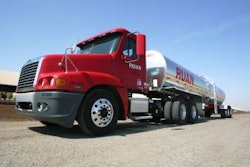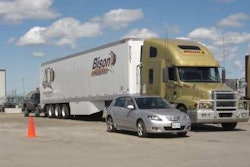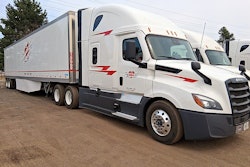 Transport America established a two-tier incentive program to encourage drivers to reduce idling -- which netted a reduction in both carbon footprint and operating costs.
Transport America established a two-tier incentive program to encourage drivers to reduce idling -- which netted a reduction in both carbon footprint and operating costs.
When diesel prices soared last year, most fleets took a closer look at driver behaviors that affect fuel costs. Governing trucks at lower speeds was an easy solution compared to reducing engine idling. Drivers might see management as unfair — even inhumane — if asked to limit idling during the extremes of winter and summer.
Transport America — an Eagan, Minn.-based truckload carrier — has used incentive programs to reduce idling significantly without rattling drivers. Several years ago, the company offered a bonus to drivers that allowed their trucks to be governed at 62 mph.
But in May 2008, record fuel prices forced the company to mandate lower speeds throughout its fleet. The voluntary-to-mandatory transition went fairly smooth, since 30 percent of drivers already had volunteered to have their trucks governed, says Bart Giangiacomo, fuel specialist and manager of special projects.
Giangiacomo knew limiting idling would be a greater challenge. “We were upfront with our drivers and told them it wouldn’t be easy,” he says. “It wasn’t like a bad load that was here today and gone tomorrow, but something they would have to deal with on every break.”
In May 2005, Transport America had introduced a penny-per-mile bonus to drivers who met a monthly target for idle percentage. Transport America tracks drivers’ idle time starting after five minutes of engine run time. This measure, called intertrip idle time, is divided by total engine run time to calculate an idle percentage and is tracked automatically by the electronic control module (ECM) of vehicles.
When Transport America started the incentive program, total fleet idle was 50 percent; by the end of 2006, idle time had dropped to 38 percent.
A two-tier strategy
By the time the fuel crisis hit in 2008, idle time had dropped to 27 percent when Transport America created a two-tier incentive program to gain further reductions. The idea for the program came from a veteran driver who routinely kept his idle percentage at zero, Giangiacomo says.
The two-tier program offers drivers the opportunity to earn up to two cents per mile for meeting two types of monthly goals. One goal is for a driver’s actual or unadjusted idle time; the other goal is for adjusted idle time. The goal for actual idle time is stricter than the goal for adjusted idle. The goals change each month based on seasonal temperatures; the company allows drivers to idle more during the winter and summer than in the spring and fall.
As an example, September’s unadjusted idle goal was 10 percent, and the adjusted goal was 20 percent. These monthly goals are the same for all drivers, with the exception that drivers assigned to vehicles with diesel-fired bunk heaters have a stricter target during the winter.
The two-tier system was designed to show drivers that management understands their work environment, Giangiacomo says. By adding a goal for adjusted idle time, drivers have the freedom to idle vehicles during extreme temperatures — above 80 degrees in the summer and below 30 degrees in the winter — without having the time counted against their bonus for adjusted idle time.
If a driver wants to idle, he sends an electronic message to request a certain number of hours. The manager checks the location of the driver and, if necessary, verifies the temperature of the location through the Internet.
Once the request is approved, the manager enters the adjustment into a software application that tracks each driver’s actual and adjusted idle percentages. The software shows the complete history of each driver’s idle performance since they started with the company, including a history of the adjustments they requested.
A driver’s adjusted idle time is calculated by subtracting the number of hours the driver requests from the numerator and denominator of the equation for idle percentage. Thus, the adjustments do not count against the driver’s cumulative total for adjusted idle percentage and do not factor into the bonus of one cent per mile.
With Transport America’s two-tier bonus program, drivers have an incentive to limit the number and duration of adjustments to achieve their goal for unadjusted idle time. For example, instead of requesting a full 10-hour adjustment for a break during 90-degree weather, a driver may decide to request only two hours to precool his truck.
About 600 of Transport America’s 850 company drivers are earning an extra penny per mile. About 300 drivers are earning two cents per mile regularly by exceeding company goals for both adjusted and unadjusted idle time. The average bonus pay for drivers is $1,392 per year, Giangiacomo says.
Since implementing the two-tier bonus program, the company’s idle time has dropped to about 26 percent; last May, the company achieved a record-low 14 percent idle time. Since May 2008, the combination of mandatory speed reductions and anti-idling incentives has saved $3 million in fuel expenses, Giangiacomo says.
Keeping tabs on drivers
Fuel economy and idling aren’t the only driver performance metrics that management watches closely. Transport America has designed and developed its own software to put a lot of data at the fingertips of operations and fleet management.
“We always think of our custom software as giving us a competitive advantage to our customers and our drivers,” says Tom Benusa, chief information officer. One feature enables fleet managers to be proactive in monitoring drivers’ scheduled breaks. The system monitors location information from onboard computers and sends alerts when drivers approach their limits for hours-of-service. Fleet managers can reach out to drivers proactively to make sure they have preplanned their stops.
Transport America recently started using a driver scorecard to monitor various driver performance metrics through one application. Idling and fuel economy statistics are grouped on a trip-by-trip basis with metrics such as out-of-route mileage, utilization and service. The application gives visibility to fleet managers to identify underperformers and strong performers quickly, Benusa says.
Everyone in the organization helped drive idle reduction and fuel savings, Giangiacomo says. Management also shares information with drivers to generate publicity about the contribution of individual drivers to the company’s fuel savings. “The other piece that brought us success was always providing the drivers with monthly updates on how much fuel they saved the organization,” Giangiacomo says.
Voicemail announcements and personal thank-you notes are sent to drivers every month. Transport America also publishes a list of the top 200 drivers with the lowest idle percentage. During last May’s record month for low idle, the top 200 drivers had unadjusted idle at 3 percent or less.
Management also created tip sheets with ideas and feedback from drivers about how to stay comfortable without idling.
“I believe if you went to a local truckstop and talked to one of our drivers, you would find that they would be proud of their achievement at slashing idle time,” Giangiacomo says.













